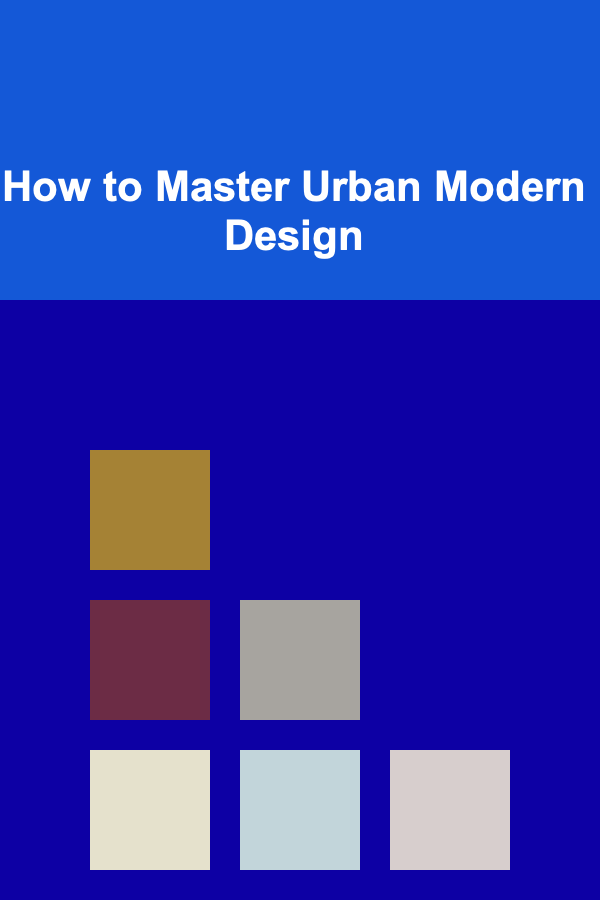
How to Master Urban Modern Design
ebook include PDF & Audio bundle (Micro Guide)
$12.99$6.99
Limited Time Offer! Order within the next:

Urban modern design is an aesthetic that blends contemporary design principles with the dynamic essence of city living. It's an approach to architecture, interiors, and cityscapes that emphasizes minimalism, clean lines, and functionality. The world around us is constantly evolving, and urban modern design reflects that fast-paced, ever-changing environment, merging innovative solutions with environmental and social consciousness. Whether you are an aspiring designer, a student of architecture, or simply a design enthusiast, mastering urban modern design requires an understanding of its history, principles, and the strategies used to create spaces that are both functional and inspiring. In this article, we'll explore the core elements of urban modern design, the skills necessary to excel in it, and how you can develop your own unique style within this genre.
Understanding Urban Modern Design
Urban modern design draws inspiration from both modernism and the urban environment. It combines contemporary styles with the influences of an industrialized cityscape. Modernism, which emerged in the early 20th century, broke away from traditional architectural styles and embraced simplicity, functionality, and clean lines. The urban influence, with its dense, complex, and often chaotic nature, introduces textures, materials, and layouts that are reflective of the bustling life of the city.
Key Characteristics of Urban Modern Design
- Minimalism: The "less is more" philosophy governs modern urban design. There's a focus on reducing unnecessary decoration and ornamentation, keeping spaces simple and streamlined.
- Functionality: Spaces are designed with a purpose, where every element has a function. Furniture, layouts, and even materials are chosen with utility in mind.
- Industrial Aesthetic: Exposed elements like brick, concrete, steel beams, and unfinished surfaces reflect the industrial influence of city architecture. These elements not only add character to a space but also tell a story of urban history.
- Open Layouts: Open floor plans are a key feature of urban modern design. These layouts maximize the use of space, often creating multi-purpose areas that blend seamlessly from one room to another.
- Neutral and Bold Color Palettes: Urban modern design often utilizes a neutral color palette with occasional bold accents. Shades of grey, black, white, and earth tones dominate, but striking pops of color---such as red, yellow, or navy blue---are often used as focal points.
- Sustainability: More and more, urban modern design incorporates sustainable materials and energy-efficient solutions. Whether through the use of recycled materials, green roofs, or solar panels, eco-conscious decisions are becoming a standard in urban spaces.
- Technology Integration: As urban spaces become more connected, smart homes and buildings are part of the urban modern design landscape. From automated lighting to smart heating systems, technology plays a key role in how we interact with urban spaces.
Historical Roots of Urban Modern Design
The origins of urban modern design can be traced back to the modernist movement of the early 20th century. Architects like Ludwig Mies van der Rohe, Le Corbusier, and Frank Lloyd Wright championed clean lines, functional spaces, and the use of industrial materials. As cities grew larger and more industrialized, the need for more efficient, adaptable designs became apparent.
In the post-World War II era, urban modern design gained momentum as cities experienced rapid growth, especially in North America and Europe. The rise of skyscrapers, large apartment complexes, and multi-functional urban spaces paved the way for the modern urban aesthetic. The 1980s and 1990s saw the emergence of loft-style living, where abandoned warehouses were transformed into chic living spaces with industrial accents, and this helped to shape the aesthetic we now know as urban modern.
The Elements of Urban Modern Design
To master urban modern design, it's essential to understand and embrace the fundamental elements that make up this style. These elements blend to create spaces that feel open, functional, and connected to the urban environment.
Architectural Elements
- Open Spaces: The hallmark of urban modern design is the open layout. The aim is to break down barriers between rooms to create fluid, multifunctional spaces. Large windows are also common to allow as much natural light as possible, making small spaces feel expansive.
- Exposed Structural Elements: Unlike traditional designs that cover structural elements, urban modern design often leaves them exposed. This includes beams, pipes, and raw brick walls, which contribute to the industrial feel of the space.
- Geometric Forms and Clean Lines: The focus is on simple, geometric forms and straight lines. Curved edges are minimized, and emphasis is placed on sharp, clean cuts that define the space.
- Natural Materials: Materials like concrete, steel, wood, and glass are frequently used to evoke a sense of modernity while staying rooted in the industrial aesthetic. The use of these materials creates texture and depth, giving the space character and authenticity.
- Integration with the City: Urban modern design emphasizes the connection between indoor spaces and the surrounding city. Often, the interior design reflects the architecture of the city in which it is located, from sleek glass facades to the rawness of old factory buildings.
Interior Design Elements
- Furniture Selection: Furniture in urban modern design is often minimalist and functional, with a focus on pieces that serve multiple purposes. For example, modular sofas or tables with hidden storage. Materials like metal, glass, and leather dominate furniture choices.
- Lighting: Lighting in urban modern spaces is crucial. Industrial-style pendant lights, recessed lighting, and track lighting are common choices. The design often focuses on using light to emphasize the architecture of the space, rather than just illuminate it.
- Color Schemes: While modern urban spaces often lean toward neutral colors like grey, black, and white, there is room for bold accents. Bright artwork, colored furniture, or a single bold wall color can add life to the space without overwhelming it.
- Decor: In keeping with the minimalist philosophy, urban modern design avoids clutter and excessive decor. Instead, the focus is on a few well-chosen art pieces, sculptures, or plants that enhance the overall ambiance of the room.
- Textures and Fabrics: Combining different textures, such as smooth leather, soft wool, and coarse stone, creates visual interest. Fabrics like linen or cotton can also add a softer contrast to the harder materials of concrete or metal.
Landscape and Outdoor Design
- Urban Gardens: With limited outdoor space in many cities, rooftop gardens or small balconies are incorporated to provide residents with green spaces. These gardens often feature minimalist design elements like sleek planters, low-maintenance plants, and seating areas.
- Public Spaces: Urban modern design also extends to public spaces like parks, plazas, and streets. These areas often feature contemporary sculptures, wide-open spaces, and sleek seating arrangements that encourage community interaction.
How to Master Urban Modern Design
Mastering urban modern design requires an understanding of the core principles and a solid grasp of how to apply them effectively. Below are strategies for honing your skills in urban modern design.
1. Study the Fundamentals of Modernism
Modernism is the foundation of urban modern design. It's crucial to understand the philosophy behind it---an emphasis on simplicity, functionality, and rejecting ornamentation. Learn from the great masters of modern architecture like Mies van der Rohe, Le Corbusier, and others who defined the movement.
2. Get Inspired by the City
Urban modern design thrives on the environment it's created in. Take time to explore the city around you. Look at the architectural features of the buildings, the textures, and the materials used in the urban landscape. Observe how the design of public spaces interacts with the people who use them.
3. Focus on Functionality
Remember that urban modern design is about more than just aesthetics---it's about creating spaces that are functional and adaptable. Whether it's in residential, commercial, or public spaces, ask yourself how each element of the design can serve a purpose. Incorporate furniture, layouts, and materials that solve problems or improve the daily life of users.
4. Experiment with Materials
One of the most exciting aspects of urban modern design is the wide array of materials you can work with. Don't be afraid to experiment with concrete, glass, steel, and wood. Learn about their properties and how they can be used in different contexts. Explore sustainable materials that are becoming increasingly popular in modern urban spaces.
5. Create a Strong Sense of Place
Urban modern design is about creating spaces that feel connected to their surroundings. When designing a space, think about how it interacts with the city around it. Use the city's history, culture, and natural environment as inspiration for your design. This connection to place makes the design feel more authentic and relevant.
6. Stay Updated with Trends
Urban modern design is an ever-evolving field. While the core principles remain constant, new trends and technologies are constantly shaping the way we approach urban spaces. Stay informed about the latest developments in sustainable design, smart home technology, and the latest material innovations.
7. Practice, Practice, Practice
Finally, the best way to master urban modern design is through continuous practice. Whether you're working on small residential projects or large-scale urban developments, each project offers valuable learning opportunities. Analyze your designs, seek feedback from peers and mentors, and continually refine your approach.
Conclusion
Urban modern design is more than just an aesthetic---it's a reflection of our changing urban environments and our desire for spaces that are both functional and inspiring. Mastering this design style requires a deep understanding of modernism, an eye for simplicity, and an appreciation for the way design interacts with the city around it. Whether you're designing a small apartment or a large public space, urban modern design offers endless possibilities for creativity and innovation.
By focusing on the principles of minimalism, functionality, and sustainability, and continuously learning from the world around you, you can develop a style that not only embraces the modern urban aesthetic but also creates spaces that improve the way we live, work, and interact with our environment.

How to Budget Effectively for a Balanced Financial Future
Read More
How to Create a Seasonal Tool Checklist
Read More
How to Manage Your Finances During Major Life Changes
Read More
How to Set Up a Family Room Snack Station for Movie Nights
Read More
How to Use Blockchain for Cross-Border Payments
Read More
How To Review Short Films Effectively
Read MoreOther Products

How to Budget Effectively for a Balanced Financial Future
Read More
How to Create a Seasonal Tool Checklist
Read More
How to Manage Your Finances During Major Life Changes
Read More
How to Set Up a Family Room Snack Station for Movie Nights
Read More
How to Use Blockchain for Cross-Border Payments
Read More